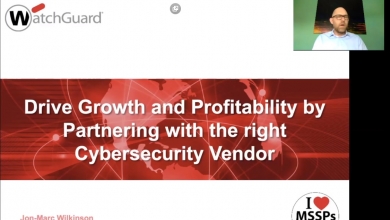
WatchGuard has centralised its security services,aiming at a streamlined deployment while simplifying zero-trust adoption. Aimed at MSPs, WatchGuard® Technologies has a new single, centralised interface for delivering and managing network security, advanced threat detection, MFA (Multi-Factor Authentication), and more,
The latest version incorporates WatchGuard’s ThreatSync features, advanced Firebox policy management capabilities and authentication policies that enable zero-trust. MSPs can create policy templates for easy, repeatable security deployments across many subscriber accounts, which "makes it simple to manage and report on Firebox security environments and AuthPoint MFA deployments from a single pane of glass", while its interface aims to help MSPs minimise administrative tasks.
“Our vision for WatchGuard Cloud has always been to build a powerful, cloud-hosted security platform that directly supports the way MSPs do business and simplifies every aspect of security delivery for our partners,” said Andrew Young, senior vice president of product management at WatchGuard. “The latest edition brings new levels of simplicity, flexibility and scalability to security deployments, management and reporting. WatchGuard Cloud’s continued evolution is lowering the barrier to entry for MSPs to add security to their portfolios and solidifying it as the management platform of choice for the security channel.”
Additionally, WatchGuard’s new approach to policy creation reduces the number of rules MSPs must manage. This makes implementing rule changes and auditing configurations faster and easier, with less opportunity for mistakes, it says. WatchGuard Cloud offers "one-click" security service implementations and pre-configured policies to deploy content scanning, network inspection, content filtering, and other services at scale. WatchGuard Cloud policy templates can apply configurations to appliances across multiple tiers and tenants, enabling MSPs to quickly onboard new customers and scale deployments with group and company policies, it says.
Enabling risk-based authentication is an essential step that organisations must take when adopting a zero-trust approach, so the new AuthPoint risk framework policies in WatchGuard Cloud aim to improve identity management capabilities by providing customisable and flexible rules to configure users and devices based on level of risk.
“Strong authentication has always been a fundamental component of security and today represents a core tenet of the growing zero-trust movement. Every organisation needs MFA protection that’s not only powerful but intuitive and scalable to manage,” said Alex Cagnoni, director of authentication at WatchGuard. “This simplified approach to managing authentication within WatchGuard Cloud is the latest example of our continued investment in making MFA more secure, effective and easier to administer with AuthPoint.”


